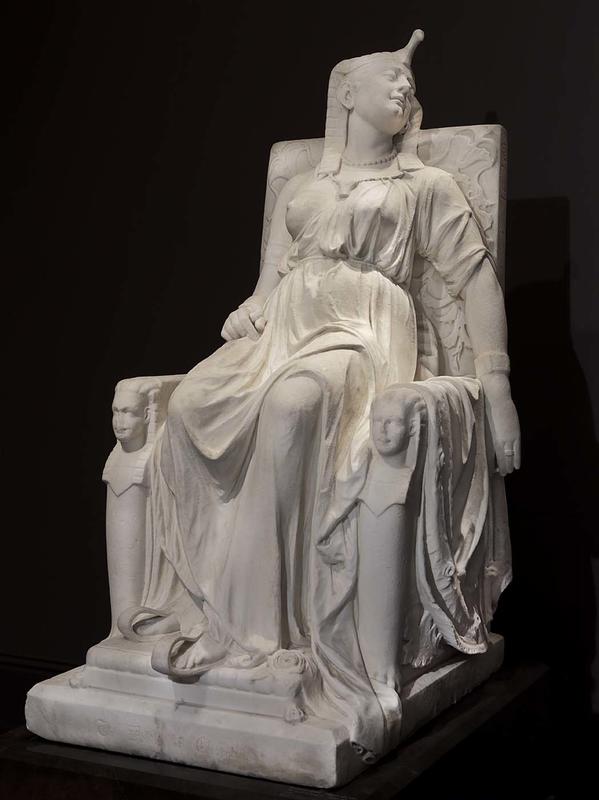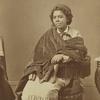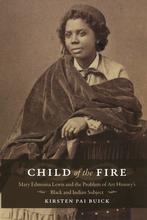The Death of Cleopatra stunned art critics, found its horse soul mate, and was tortured by Boy Scouts before finally making it to a museum.
For the 1886 Philadelphia Centennial Exposition, Edmonia Lewis presented The Death of Cleopatra, a two-ton marble sculpture depicting the greatest Egyptian queen of all time and her crowning achievement as a sculptor.
Cleopatra’s death may be the most famous death in all of history because (a) she chose to meet the pearly gates through Death by reptile and (b) when she was not dead, she made a business out of seducing powerful men. The subject of Cleopatra enchanted nineteenth-century artists, who fantasized about the extraordinary circumstances of her death. Even for the most morbid historian, decapitation seemed like drab, unwashed linen compared to a sharp kiss from Voldemort’s best bud.
Lewis, unlike most artists, stuck close to the history books when depicting Cleopatra, referring to authentic records like coins to shape her face. That way, if anyone questioned Cleopatra’s race, she could throw them the history book and soundly shut them up. The biggest deal about Lewis’s Cleopatra is her nose, which is distinctly aquiline in profile and true to reference. The faces on the arms of the chair depict the twins Cleopatra had with Mark Antony, which, sure, seems sweet at first but becomes creepier the more you look at it.
Sorry, babes, but Mommy just needs a quick breather. (Oh, she’s not breathing anymore.)
For a woman having suffered a deadly snakebite, though, Cleopatra looks pretty good. Mainstream critic William Clark called her situation “absolutely repellent,” but a closer examination of her face clearly reveals Cleopatra enjoying the tranquil death nap so popular in art of the period.
Clark did continue by saying, “the striking qualities of the work are undeniable, and it could only have been produced by a sculptor of genuine endowments,” so at least he had the sense of recognizing Lewis’s genius. The People’s Advocate, an African-American run newspaper, boasted that Lewis’s statue got more views than any of the other 673 works in the Exhibition. In the 21st century, we would call such a work “viral.”
The post-Exhibition life of Cleopatra gets a little rocky, though. Too tired to carry a two-ton marble corpse back to Rome, Lewis placed it in a storage facility in Chicago. Somehow, it made its way to a saloon in 1892 and then into the hands of a notorious gambler and racehorse tycoon named “Blind John” Condon, who used it as the gravestone for his favorite horse, Cleopatra.
Evidently, Condon found a lot in common between the real Cleopatra and the hooved one. With “Blind” as a nickname, though, you may find that practically everything has something in common.
When the racetrack turned into a USPS service facility in the 1970s, Cleopatra traveled to a storage yard, where a fire inspector and his son’s Boy Scout troop rescued it and cleaned it. They also painted it white because at that time, white-washing was ok.
A biographer working on Edmonia Lewis’s life story sent out a query for Lewis’s last known sculpture and, after visiting Cleopatra in a local shopping mall, knew she’d found it. The queen had not aged well, though, and it took $30,000 to restore her to tip-top shape. With only one photograph of the original sculpture to refer to, conservators found the task one hell of a job.
The Death of Cleopatra now stands in the Smithsonian American Art Museum, as dignified and badass as Edmonia Lewis first carved her close to a century ago. Not quite African yet not quite Anglican, Cleopatra reminds us of the sexy, strong queen it was modeled after and the vastly underrated interracial artist who made it.















Many neoclassical artists make death look like a dramatically posed nap, which I find to be somewhat humorous. Edmonia Lewis's statue of Cleopatra looks very similar to other works telling the same story, such as 'The Death of Cleopatra' by Juan Luna and 'The Death of Cleopatra' by Hans Makart, by Cleopatra's body language and undead appearance. But we can appreciate the research that Lewis put into this work so that it could more accurately resemble Cleopatra's true appearance, especially compared to earlier pieces, such as 'The Death of Cleopatra' by Williem Van Mieris.